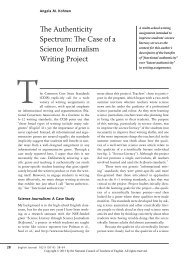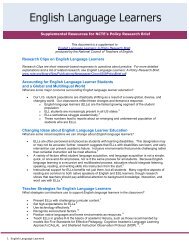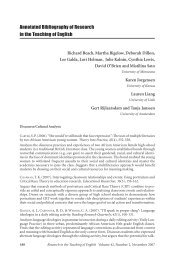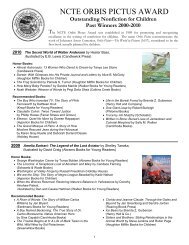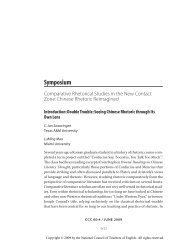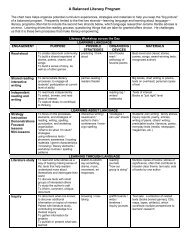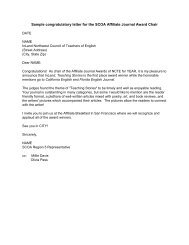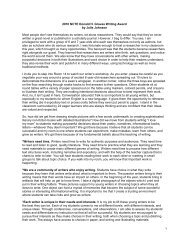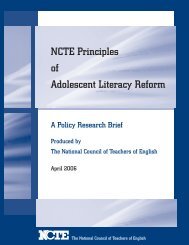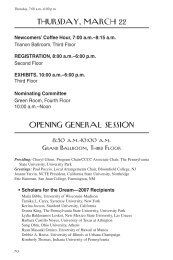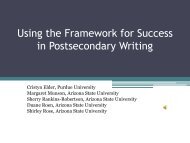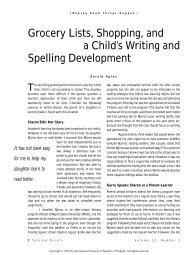Annotated Bibliography of Research in the Teaching of English
Annotated Bibliography of Research in the Teaching of English
Annotated Bibliography of Research in the Teaching of English
- No tags were found...
You also want an ePaper? Increase the reach of your titles
YUMPU automatically turns print PDFs into web optimized ePapers that Google loves.
234 <strong>Research</strong> <strong>in</strong> <strong>the</strong> Teach<strong>in</strong>g <strong>of</strong> <strong>English</strong> Volume 41 November 2006Discusses <strong>the</strong> results <strong>of</strong> a four-year longitud<strong>in</strong>al study <strong>of</strong> <strong>the</strong> attitudes, beliefs, and experiences<strong>of</strong> 18 preservice teachers about <strong>the</strong> use <strong>of</strong> popular culture <strong>in</strong> <strong>the</strong> primary literacy curriculum <strong>in</strong>England aga<strong>in</strong>st <strong>the</strong> backdrop <strong>of</strong> <strong>in</strong>creased centralization and government control <strong>of</strong> teachereducation <strong>in</strong> England. Focuses on group <strong>in</strong>terview data <strong>of</strong> years one and three for three <strong>of</strong> <strong>the</strong>orig<strong>in</strong>al 18 participants purposefully selected because <strong>of</strong> <strong>the</strong> <strong>the</strong>oretical frameworks <strong>the</strong>y represented<strong>in</strong> <strong>the</strong>ir responses. Illustrates that positive attitudes toward <strong>the</strong> use <strong>of</strong> popular mediarelated to <strong>the</strong> way <strong>in</strong> which popular-culture texts could be used to enhance motivation andorient children toward schooled literacy practices ra<strong>the</strong>r than valu<strong>in</strong>g popular media <strong>in</strong> its ownright or as a way to promote critical literacy. Us<strong>in</strong>g Bourdieu’s formula (habitus x capital) +field = practice (1984, p. 101), concludes that habitus counteracted preservice teachers’ <strong>in</strong>cl<strong>in</strong>ationsto use popular culture, based on <strong>the</strong>ir utilitarian beliefs that popular texts could be used toorient children to schooled literacy practices.MAPLES, J., & GROENKE, S. (2005). The Web Pen Pals Project: Students’ perceptions <strong>of</strong> a learn<strong>in</strong>gcommunity <strong>in</strong> an onl<strong>in</strong>e synchronous environment. Journal <strong>of</strong> Interactive Onl<strong>in</strong>e Learn<strong>in</strong>g, 4(2).Retrieved June 26, 2006 from http://www.ncolr.org/jiolDraws on data ga<strong>the</strong>red from a five-month phenomenological study <strong>of</strong> middle-school students’perceptions <strong>of</strong> <strong>the</strong> effects <strong>of</strong> computer-based technologies on a learn<strong>in</strong>g community <strong>in</strong> an onl<strong>in</strong>esynchronous environment. Twenty-four 8th-grade students participated <strong>in</strong> <strong>the</strong> Web Pen PalsProject, a university-secondary telecollaborative partnership, which br<strong>in</strong>gs middle-school studentstoge<strong>the</strong>r with preservice teachers enrolled <strong>in</strong> an adolescent literature course <strong>in</strong> onl<strong>in</strong>echat rooms to discuss young adult literature. The complexities <strong>of</strong> creat<strong>in</strong>g a community areexplored through <strong>in</strong>terviews <strong>of</strong> <strong>the</strong> middle school participants, which reveal several <strong>the</strong>mesaffect<strong>in</strong>g <strong>the</strong> development <strong>of</strong> a learn<strong>in</strong>g community: 1) obstacles to community-mak<strong>in</strong>g, which<strong>in</strong>clude anonymity and lack <strong>of</strong> ease with technology; 2) establish<strong>in</strong>g friendships; 3) an emergentlanguage system; and 4) <strong>the</strong> symbolic <strong>in</strong>version <strong>of</strong> traditional “teacher” and “student” roles.MCGRAIL, E. (2006). “It’s a double-edge sword, this technology bus<strong>in</strong>ess”: Secondary <strong>English</strong>teachers’ perspectives on a schoolwide laptop technology <strong>in</strong>itiative. Teachers College Record,108(6), 1055-1079.Exam<strong>in</strong>es a group <strong>of</strong> <strong>English</strong> teachers’ experiences with a top-down technology implementationeffort. Identifies tensions between community expectations for technology <strong>in</strong>struction and<strong>the</strong> teachers’ sense <strong>of</strong> what is and is not an appropriate curricular goal <strong>in</strong> <strong>English</strong> class, as well astensions between <strong>the</strong> teachers’ views <strong>of</strong> literacy and <strong>the</strong> goals <strong>of</strong> <strong>the</strong> technology <strong>in</strong>itiative. Suggests<strong>the</strong> need to consider how technology <strong>in</strong>tegration is less about develop<strong>in</strong>g technical skillthan about f<strong>in</strong>d<strong>in</strong>g ways for teachers to determ<strong>in</strong>e how to <strong>in</strong>corporate any tool <strong>in</strong> ways that areconsonant with <strong>the</strong>ir pr<strong>of</strong>essional identity and pr<strong>in</strong>ciples.RIDEOUT, W., & HAMEI, E. (2006). The media family: Electronic media <strong>in</strong> <strong>the</strong> lives <strong>of</strong> <strong>in</strong>fants, toddlers,preschoolers, and <strong>the</strong>ir parents. Menlo Park, CA: Kaiser Family Foundation. Retrieved July5, 2006 from http://www.kff.org/entmedia/7500.cfmReports on a national survey <strong>of</strong> 1,051 parents with children age six months to six years and aseries <strong>of</strong> focus groups across <strong>the</strong> country focus<strong>in</strong>g on children’s screen media use. Children agesfour to eight view an average <strong>of</strong> about two hours <strong>of</strong> television a day. Households <strong>in</strong> which heavyTV use is supported by parents have children who watch more TV than o<strong>the</strong>r households.Parents <strong>of</strong> heavy-use households who use media to help occupy <strong>the</strong>ir children feel more positivelyabout its educational and social impact on <strong>the</strong>ir children than parents <strong>of</strong> lower-use households.RILEY, N. R. (2006). Methods for evaluat<strong>in</strong>g critical learn<strong>in</strong>g us<strong>in</strong>g onl<strong>in</strong>e discussion forums.Technology, Pedagogy and Education, 15(1), 63-78.Evaluates critical learn<strong>in</strong>g <strong>of</strong> 10- to11-year-old students study<strong>in</strong>g global citizenship through anonl<strong>in</strong>e discussion environment. Analyzes <strong>the</strong> use <strong>of</strong> language as both a social reason<strong>in</strong>g tool and



